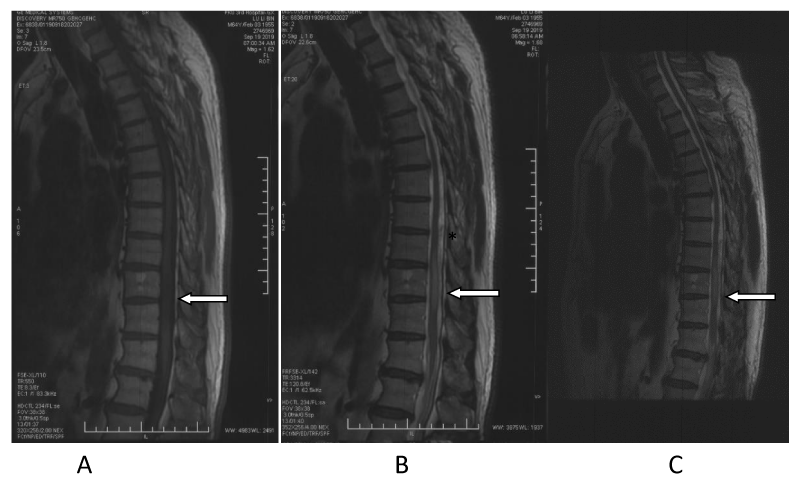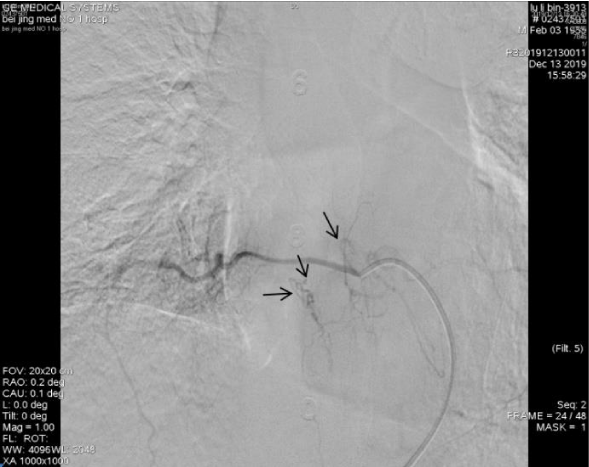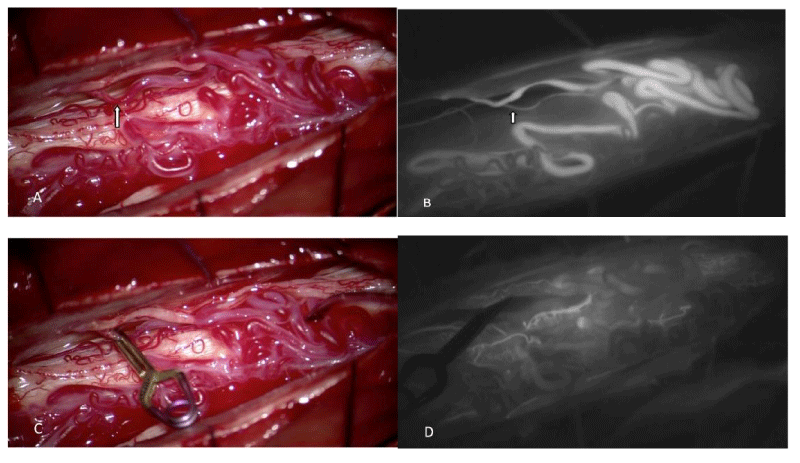Global Journal of Medical and Clinical Case Reports
Spinal angiography in a patient with spinal dural arteriovenous fistula was falsely reported as normal: A Case Report
Tian Jiayu1, Jin Haiqiang1, Duan Hongzhou2 and Sun Yongan1*
2Department of Neurosurgery, Peking University First Hospital, Beijing, China
Cite this as
Jiayu T, Haiqiang J, Hongzhou D, Yongan S (2020) Spinal angiography in a patient with spinal dural arteriovenous fistula was falsely reported as normal: A Case Report. Glob J Medical Clin Case Rep 7(1): 019-021. DOI: 10.17352/2455-5282.000084Introduction: Spinal Dural Arteriovenous Fistulae (SDAVF) is a vascular malformation of the spinal cord. Digital Subtraction Angiography (DSA) is the gold standard for the diagnosis. Sometimes there are false negatives.
Case Report: The authors describe a 62-year-old male with SDAVF. He presented with a slow ascent of sensory and motor impairments. DSA showed normal at first, but showed the presence of SDAVF in the second time.
Conclusion: DSA is needed to diagnose the suspected dural arteriovenous fistula, but it can’t be excluded completely if the contrast is negative. If the symptom is typical, DSA can be rechecked as appropriate to further clarify, avoid misdiagnosis and mistreatment as much as possible, and improve the prognosis of the patients.
Introduction
Spinal Dural Arteriovenous Fistulae (SDAVF) is the most common spinal arteriovenous malformation [1] . There are usually one or more blood supply arteries and one drainage tube around the dura mater near the spinal nerve root [2]. Digital Subtraction Angiography (DSA) is the gold standard for the diagnosis of SDAVF. This paper reports a case of SDAVF with negative primary angiography, and discusses the diagnosis of the disease.
Case presentation
In March 2019, the 62-year-old male patient appeared numbness and weakness of the foot to knee joint, unstable walking, dysuria and constipation. It worsened gradually in several months. MRI of thoracic vertebrae was performed (Figure 1) and DSA showed normal. He was treated for benign prostatic hyperplasia, lumbar disc herniation, and demyelination of the nervous system, but none of the treatments worked. After admission, Cerebrospinal Fluid (CSF) examination showed slightly elevated biochemical protein of 0.73g/L. No abnormality was found in thyroid antibody, ANA, ENA spectrum and ANCA. Negative antibody against measles virus. PPD test was negative, and no abnormality was found in tb-spot test. CSF cytology showed no tumor cells. We considered a possible vascular malformation of the spinal cord, and the result of DSA confirmed it (Figure 2). Then, the dural arteriovenous fistulectomy was performed through the posterior median approach under general anesthesia (Figure 3). After 6 weeks of follow-up, numbness and weakness were reported to be better than before, and he could walk independently.
Discussion
The most common clinical manifestation of SDAVF is weakness of the lower limbs or sensory disturbance, and the symptoms gradually progress [3]. Because of its long course, nonspecific clinical manifestations, and relatively rare, it is easy to be misdiagnosed as lumbar disc herniation, benign prostatic hyperplasia, central nervous system demyelinating disease, etc. MRI of the spinal cord can be used as a preliminary screening. Spinal DSA is the gold standard for the diagnosis of SDAVF. Most SDAVFs occur in the thoracolumbar segment [4-5]. The dural arteriovenous fistula is mainly located around the nerve root, and the arterial supply is provided by the posterior root retinal branch of the corresponding segmental root artery. Venous drainage includes the posterior nerve root vein, etc. In 80%-90% of cases, the draining vein is the medulla bulbus vein and venous plexus located on the back of the spinal cord [6]. In this case, the blood supply artery is the left T8 artery, the fistula is located at the entrance of the left T8 nerve root, and the draining vein is the venous plexus located on the back of the spinal cord, which is consistent with the common characteristics of dural arteriovenous fistula. Therefore, it is meaningful to analyze the reasons of falsely reported as normal DSA in this case.
There were also reports of normal DSA examination for the first time abroad. Barreras et al. also reported a group of cases with normal DSA misreporting of spinal vascular malformations, in which 55.6% of the lesions were recorded by angiography but not noticed, 29.6% of the lesions were not recorded by angiography, and 14.8% of the patients were not injected enough7. The reasons for DSA misstatement of dural arteriovenous fistula are as follows: the position of dural arteriovenous fistula was not recognized, that is, the position of dural arteriovenous fistula was mostly located near the intervertebral foramen, which changed from thin to thick suddenly. Selective myelography is incomplete due to factors such as wrong vertebral body and marker displacement. Sometimes L3 or below vascular malformations were not included in the planned angiography [7]. Insufficient injection, only a small amount of contrast agent through the lesion vessels; In some patients with spinal cord vascular malformations, the venous phase of angiography was normal [8], which may also lead to DSA misdiagnosis.
To avoid false negative results, it is recommended to carefully examine the vertebral plane before angiography, complete spinal angiography if possible, and repeat the angiography results after angiography. Although venous deletion is an important angiographic sign, it is not recommended as a reason to rule out vascular malformations.
Misdiagnosis of dural arteriovenous fistula can lead to a high disability rate, which is often irreversible despite surgical or intravascular treatment of the fistula [9]. Suspected dural arteriovenous fistulas should be diagnosed by DSA, but the diagnosis can not be excluded completely if the contrast is negative. DSA can be reexamined for patients with typical symptoms. In general, if the disease can be diagnosed and treated early, the prognosis is better [10].
Conclusion
SDAVF is easy to be misdiagnosed and mistreated. As a gold standard, DSA also has the possibility of false negative. If the symptom is typical, DSA can be rechecked as appropriate to further clarify, avoid misdiagnosis and mistreatment as much as possible, and improve the prognosis of the patients.
Funded by National Key R&D Program of China (2018YFC1314200)
- Hernandez-Gerez E, Fleming IN, Parson SH (2019) A role for spinal cord hypoxia in neurodegeneration. Cell Death Dis 10: 861. Link: https://bit.ly/2VZIizx
- Li J, Li G, Bian L, Hong T, Yu J, et al. (2017) Concomitant Lumbosacral Perimedullary Arterioveous Fistula and Spinal Dural Arteriovenous Fistulla. World Neurosurg 105: 1041.e7-1041. Link: https://bit.ly/2yK4YvK
- Lee J, Lim YM, Suh DC, Rhim SC, Kim SJ, et al. (2016) Clinical presentation, imaging finding, and prognosis of spinal dural arteriovenous fistula. J Clin Neurosci 26: 105-109. Link: https://bit.ly/2W0I636
- Takai K, Kin T, Oyama H, Shojima M, Saito N (2013) Three-dimensional angioarchitecture of spinal dural arteriovenous fistulas, with special reference to the intradural retrograde venous drainage system. J Neurosurg Spine 18: 398-408. Link: https://bit.ly/2KuOlqL
- Takai K, Komori T, Taniguchi M (2015) Microvascular anatomy of spinal dural arteriovenous fistulas: arteriovenous connections and their relationships with the dura mater. J Neurosurg Spine 23: 526-533. Link: https://bit.ly/35fgPOV
- Sorenson T, Giordan E, Cannizzaro D, Lanzino G (2018) Surgical ligation of spinal dural arteriovenous fistula. Acta Neurochir (Wien) 160: 191-194. Link: https://bit.ly/2xchpQQ
- Barreras P, Heck D, Greenberg B, Wolinsky JP, Pardo CA, et al. (2017) Analysis of 30 Spinal Angiograms Falsely Reported as Normal in 18 Patients with Subsequently Documented Spinal Vascular Malformations. AJNR Am J Neuroradiol 38: 1814-1819. Link: https://bit.ly/2S63tit
- Eckart Sorte D, Obrzut M, Wyse E, Gailloud P (2016) Normal Venous Phase Documented during Angiography in Patients with Spinal Vascular Malformations: Incidence and Clinical Implications. AJNR Am J Neuroradiol 37: 565-571. Link: https://bit.ly/2VCdAO1
- Brinjikji W, Nasr DM, Morris JM, Rabinstein AA, Lanzino G (2016) Clinical Outcomes of Patients with Delayed Diagnosis of Spinal Dural Arteriovenous Fistulas. AJNR Am J Neuroradiol 37: 380-386. Link: https://bit.ly/3bC6OO7
- Bretonnier M, Henaux PL, Gaberel T, Roualdes V, Kerdiles G, et al. (2019) Spinal Dural Arteriovenous Fistulas: Clinical Outcome After Surgery Versus Embolization: A Retrospective Study. World Neurosurg 127: e943-e949. Link: https://bit.ly/2VXXKMQ

Article Alerts
Subscribe to our articles alerts and stay tuned.
 This work is licensed under a Creative Commons Attribution 4.0 International License.
This work is licensed under a Creative Commons Attribution 4.0 International License.



 Save to Mendeley
Save to Mendeley
